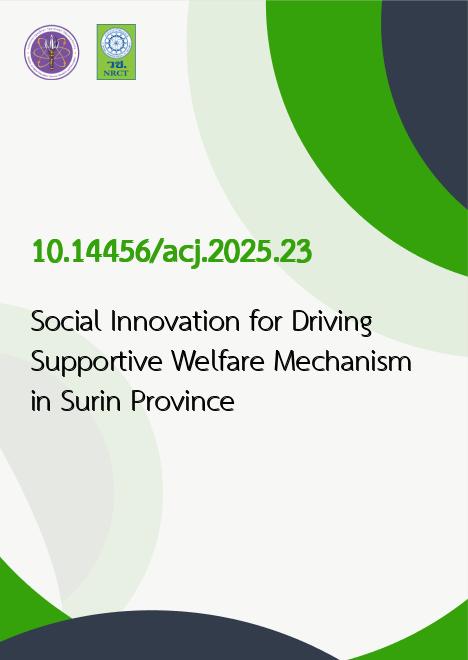
|
Social Innovation for Driving Supportive Welfare Mechanism in Surin Province |
|---|---|
| รหัสดีโอไอ | |
| Creator | Ubonwan Suwannapusit |
| Title | Social Innovation for Driving Supportive Welfare Mechanism in Surin Province |
| Contributor | Napapan Pattachatchai, Nisanart Kaewwinud |
| Publisher | The Office of Arts and Culture, Surindra Rajabhat University |
| Publication Year | 2568 |
| Journal Title | Arts and Culture Journal of the Lower Moon River |
| Journal Vol. | 14 |
| Journal No. | 2 |
| Page no. | 310-321 |
| Keyword | Social Innovation, Supportive Welfare Mechanism, Solve Poverty Alleviation |
| URL Website | https://so07.tci-thaijo.org/index.php/acj |
| Website title | วารสารศิลปะและวัฒนธรรมลุ่มแม่น้ำมูล |
| ISSN | ISSN 2822 - 0617 (Online);ISSN 2822 - 1141 (Print) |
| Abstract | Project Design to Assist the Extremely Poor and Vulnerable Groups Based on the Analysis and Utilization of the PPPConnext Database and the Provincial Sustainable Poverty Eradication and Development Center (PPEDC) According to the Philosophy of Sufficiency Economy. This research and development aims to drive a welfare support mechanism in Surin Province through social innovation involving 1,400 targeted poor individuals from 17 districts in Surin. The concept of social innovation is used as a process to promote an appropriate welfare support mechanism suitable to the context of Surin Province, based on Buddhist principles and the “Baworn” power concept through six steps including 1) inspiration and internal motivation; 2) brainstorming; 3) prototyping and testing; 4) sustainability; 5) scaling up; and 6) systemic change. The research findings show as follows 1) Psychologically, participants received empowerment that strengthened life stability, building resilience and guidance to adapt happily in contemporary society with an emphasis on self-reliance, 2) Regarding the four basic necessities of life, through aid and forwarding of needs information to network partners, 23 houses were repaired or built, dry rice and food were provided to 1,550 households, medicine and medical devices to 938 households, clothing to 228 households, and scholarships to 51 households, and 3) For livelihood factors, support was given in materials, tools, and raw materials to promote occupations and generate income for 100 households. Social impacts include improved quality of life among the poor in terms of social support, health, and housing, by encouraging community participation in solving local poverty issues. |